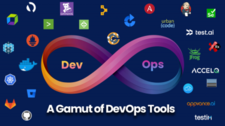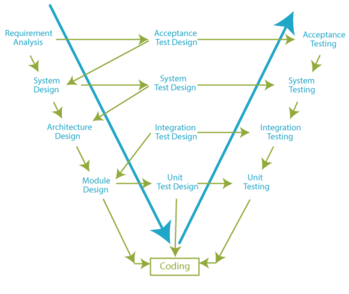Upgrade & Secure Your Future with DevOps, SRE, DevSecOps, MLOps!
We spend hours on Instagram and YouTube and waste money on coffee and fast food, but won’t spend 30 minutes a day learning skills to boost our careers.
Master in DevOps, SRE, DevSecOps & MLOps!
Learn from Guru Rajesh Kumar and double your salary in just one year.
What is Software Development Lifecycle (SDLC)?
Software Development Life Cycle (SDLC) is a process employed by the software industry. It helps to style, develop and test top quality software. it’s a technique which has clearly defined processes for creating low-cost and high-quality software. It provides a well-structured flow of phases which help a corporation to supply high-quality software quickly which is well-tested and prepared for production use.
Why do we need SDLC?
A system development life cycle helps to minimize the complexity of developing a system from scratch. It’s important to possess an SDLC in situ because it helps to rework the thought of a project into a functional and completely operational structure. Additionally to covering the technical aspects of system development, SDLC helps with process development, change management, user experience, and policies. Another advantage of an SDLC is that it allows for planning before time, determine costs and staffing decisions, define goals, measure performance, and validate points at each phase of the cycle to spice up the standard of the ultimate product.
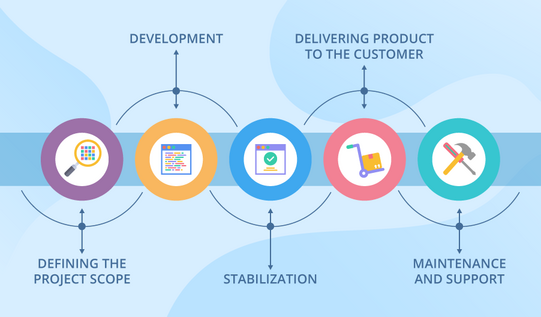
What are the Benefits of the Software Development Lifecycle?
- Gives an outlined view of the complete system, resources, timeline, and goals
- Design reviews help to make sure the reliability and quality of the ultimate product
- Enhanced control over large or complex projects
- Involves clear and comprehensive steps
- Provide goals and deliverables that meet the standards of every party involved within the project, requires keeping detailed documentation throughout the whole process.
- Easy estimation of costs and growth of the developed system.
What are the SDLC phases?
The seven phases of SDLC are:
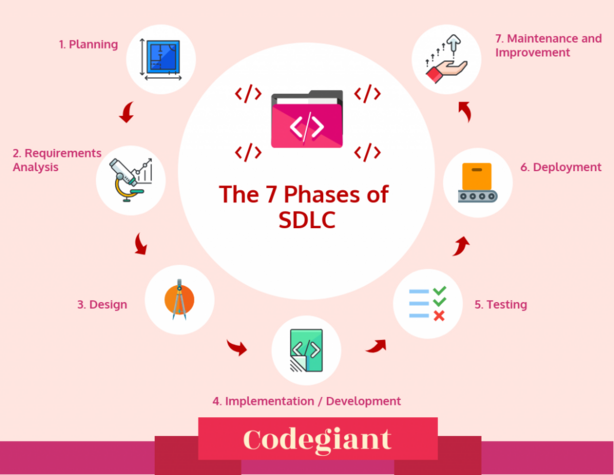
1.Planning- In the Planning phase, project leaders evaluate the terms of the project. This includes calculating material and labor costs, creating a timetable with target goals, and creating the project’s teams and leadership structure. It can even include feedback from stakeholders. This step should clearly define the scope and purpose of the appliance. It plots the course and provisions the team to effectively create the software. It also sets boundaries to assist keep the project from fluctuating from its original motive.
2.Analysis-The analysis stage incorporates accumulating all the specific informations needed for a new system as well as shaping the first ideas for prototypes.
Developers may:
- Explicate any prototype system requirements
- Evaluate alternatives of the prototypes existing
- Carry out research and analysis to to see the necessities of end-users
Besides, developers will often create a software requirement specification or SRS document.This includes all the specifications for software, hardware, and network requirements for the system they attempt to build. This will prevent them from overdrawing funding or resources when engaging at the identical place as other development teams.
3.Design- Some facets of the design include:
- Architecture – Specifies artificial programming language, industry practices, overall design, and use of any templates or boilerplate
- User Interface – Defines the ways customers interact with the software, and the way software responds to input
- Platforms – Defines the platforms on which the software will run, like Apple, Android, Windows version, Linux, or perhaps gaming consoles
- Programming – Not just the programming language, but including methodologies of solving problems and performing tasks within the application
- Communications – Defines the methods that the appliance can communicate with other assets, like a central server or other instances of the appliance
- Security – Describes the steps taken to secure the application, and may comprise of SSL traffic encryption, password protection, and secure storage of user credentials
4.Development- This is the particular writing of the program. A tiny project may be written by one developer, while an oversized project can be choppy and worked by several teams. Use an Access Control or Source Code Management application during this phase. These systems help the developers to track changes to the code. They even help and ensure compatibility between different team projects and to ensure target goals are being met. Software developers admire instructions and explications. Documentation can be a proper process, which includes wiring a user guide for the application. It can even be informal, like comments within the source code that designate why a developer used a particular procedure. Even companies that strive to form software that’s easy and intuitive take pleasure in the documentation. It can be a fast guided tour of the application’s basic features that display on the primary launch. It can be video tutorials for complicated tasks. Documentations which are written like troubleshooting guides, user guides and FAQ’s help the users resolve problems or technical questions.
5.Testing- It’s critical to check an application before making it accessible to users. Most of the testing can be automated, like load testing. Other testing can only be carried out in a particular environment – consider creating a simulated production environment for complex deployments. Testing should make sure that each function works properly. Different parts of the application should even be tested to act seamlessly together—performance test, to cut back any hangs or lags in processing. The testing phase helps lower the amount of bugs and glitches that users come across. This results in a higher user satisfaction and an improved usage rate.
6.Implementation- After testing, the whole design for the software will come together. Different modules or designs are going to be integrated into the basic source code through the efforts of the developer, generally by leveraging training environments to identify further errors, faults or defects. The information system will be merged into its environment and will be installed in due course. After going by this stage, the software is theoretically ready for market and can be provided to any end-users.
7.Maintenance- Now, the event cycle is nearly finished. The application is finished and being operated in the field. The Operation and Maintenance phase still continues to be of importance, though. During this stage, users encounter bugs that weren’t observed during testing. These defects has to be resolved, which can generate new development cycles. Along with bug fixing, models like Iterative development plan additional features in future releases. For every release, a new Development Cycle can be introduced.
What are the different types of Software Development Life Cycle Models?
- Waterfall Model- Waterfall is the most aged and least complicated of the structured SDLC models — finish one phase, then march on to the subsequent. There is no way back. Each and every stage relies on information from the preceding stage and has a project plan of it’s own. Waterfall is simple to understand and effortless to manage.
- V-Shaped Model- Also called the Verification and Validation model, the V-shaped model came or grew out of Waterfall and is distinguished by a corresponding testing phase for every development phase. Like Waterfall, each stage begins only after the last one has finished.
- Iterative Model- The Iterative model is repetition embodied. Instead of starting with well known requirements, you enact a set of software requirements, then test, evaluate and pinpoint further requirements. A brand new version of the software is generated with each phase, or iteration. Rinse and repeat until the total system is ready to go.
- Lean- The Lean model for software development is stimulated by “lean” manufacturing practices and principles. The seven Lean principles (in this order) are: eliminate waste, amplify learning, decide as late as possible, deliver as fast as possible, empower the team, incorporate integrity, and see the full. The Lean process is about working only on what must be worked on at the time, so there’s no room for multitasking. Project teams are focused on finding opportunities to cut down waste at every turn throughout the SDLC process, from dropping unnecessary meetings to reducing the documentation.
- Spiral Model- One of the most adjustable SDLC models, the Spiral model takes a cue from the Iterative model and its repetition; the project goes through four phases over and over in an exceedingly “spiral” until completed, with multiple rounds of refinement.
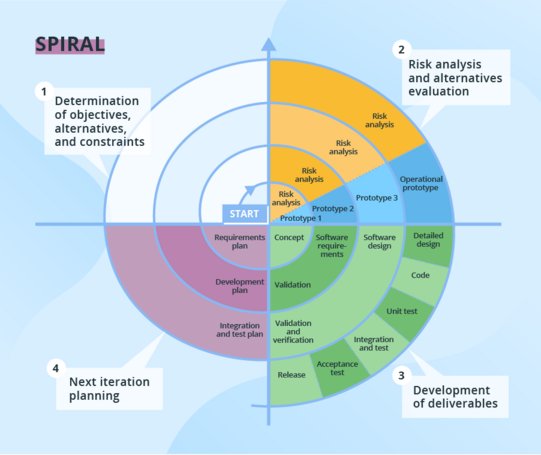
- Big Bang Model- A bit of an anomaly among SDLC methodologies, the massive Bang model follows no specific process, and extremely little time is spent on planning. the bulk of resources are thrown toward development, and even the client might not have a solid grasp of the wants. this can be one in every of the SDLC methodologies typically used for tiny projects with just one or two software engineers.
- Agile Model- By breaking the merchandise into cycles, the Agile model quickly delivers a working product and is taken into account a awfully realistic development approach. The model produces ongoing releases, each with small, incremental changes from the previous release. At each iteration, the merchandise is tested.
- DevOps- The DevOps model is that the newcomer to the SDLC scene. As this article explains, it emerged from two trends: the appliance of Agile and Lean practices to operations work, and also the general shift in business toward seeing the worth of collaboration between or together closely — and sometimes in concert team — to accelerate innovation and therefore the deployment of higher-quality and more reliable software products and functionalities. Updates to products are small but frequent. Discipline, continuous feedback and process improvement, and automation of manual development processes are all hallmarks of the DevOps model.
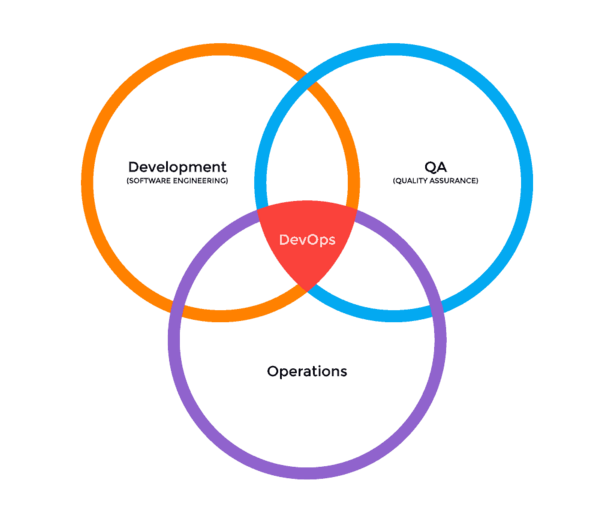
Which SDLC Model is Best?
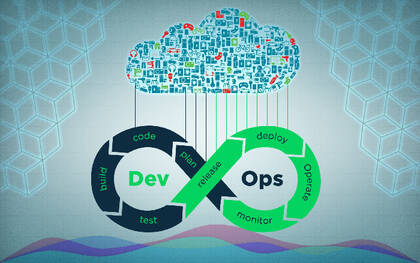
DevOps model is that the best one as developers and operations teams work together closely and side by side — and sometimes jointly team — to speed up innovation and therefore the deployment of higher-quality and more reliable software products and functionalities. Updates to products are small yet frequent. Discipline, continuous feedback and process improvement, and automation of manual development processes are all hallmarks of the DevOps model.
Ultimately, any development team in both the IT and other industries can take pleasure in implementing system development life cycles into their projects. Use the above guide to spot which methodology you would like to use in conjunction together with your SDLC for the simplest results.
